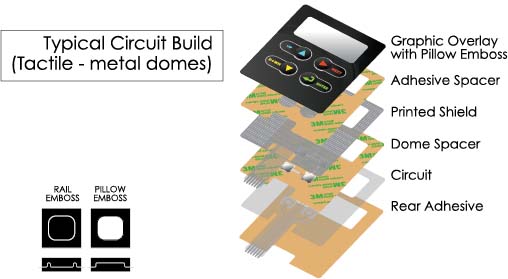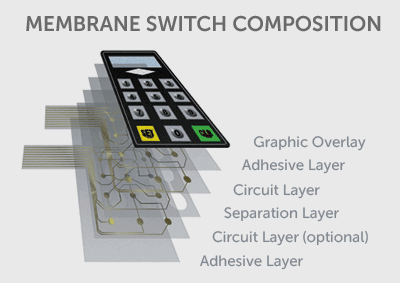Comprehending Membrane Switches Over: The Secret to Reliable and resilient Controls
Membrane changes stand for a crucial aspect of modern-day user interface design, blending capability with resilience in various applications. These functional components not just facilitate user communication however are also crafted to endure the rigors of requiring atmospheres, from clinical tools to industrial machinery. Recognizing their construction, operation, and the myriad advantages they supply is essential for designers and developers alike. As we check out the ins and outs of membrane layer buttons, it comes to be clear that their role in enhancing control systems is both intricate and profound, questioning concerning how ideal to leverage their capacities in future innovations.
What Are Membrane Switches?
Membrane layer switches are an innovative service in the realm of interface innovation, incorporating functionality and design perfectly. These gadgets function as an interface in between individuals and digital systems, incorporating numerous elements right into a small format. Typically created from adaptable, slim layers of materials, membrane layer switches are created to reply to touch, enabling individuals to interact with machinery and electronic gadgets successfully.
The main aspects of a membrane layer button include a published circuit layer, visuals overlay, and a spacer layer that stops unplanned activation. The graphic overlay can be customized to reflect brand identification or customer choices, enhancing aesthetics while making sure use. Membrane buttons are typically used in different applications, including medical gadgets, consumer electronic devices, and industrial equipment, owing to their toughness and resistance to ecological factors such as moisture and dust.
Among the crucial advantages of membrane layer buttons is their capacity to endure damage, making them perfect for high-traffic atmospheres. Additionally, they are light-weight and call for very little area, allowing for innovative designs in product growth. Overall, membrane switches stand for a reliable and sensible selection for modern-day electronic user interfaces, marrying innovation with user-centric design principles.

How Membrane Layer Switches Work
The procedure of membrane layer switches joints on a straightforward yet effective device that translates individual input right into electronic signals. When a user presses the button, the top layer warps, allowing a conductive component in the circuit layer to make call with a corresponding conductive pad on the bottom of the visuals overlay.
The layout of membrane switches can differ, yet they typically include domes or tactile elements to give responses to the user, improving the overall experience. The products made use of in membrane buttons, such as polyester or polycarbonate, contribute to their longevity and resistance to ecological elements, including moisture and dust. Furthermore, the published circuits are typically enveloped, which shields them from deterioration over time.

Benefits of Membrane Layer Buttons
One of the primary benefits of membrane layer switches is their flexibility in layout, enabling them to be personalized to fulfill particular customer requirements and aesthetic demands. This versatility reaches various sectors, where various forms, dimensions, and shades can be used to improve customer interaction and visual allure.
Additionally, membrane layer buttons are recognized for their toughness. Built from robust materials, they are immune to dirt, moisture, and physical wear, which substantially extends their lifespan contrasted to standard mechanical buttons. This resilience makes them specifically appropriate for high-traffic environments and applications needing durability.

Moreover, membrane layer switches offer a streamlined account, leading to a thinner layout that can be incorporated right into different gadgets without adding bulk. This function not just improves the visual find out here allure but additionally adds to a much more ergonomic product design.

Applications of Membrane Layer Switches
User-friendly and versatile, membrane buttons discover applications across a large range of industries, consisting of medical devices, consumer electronic devices, and industrial tools. In the medical area, these switches are indispensable to tools such as analysis devices, patient tracking systems, and mixture pumps, where reliability and convenience of cleaning are important. Their capability to endure harsh atmospheres and preserve performance makes them ideal for such applications.
In customer electronics, membrane switches are made use of in products like microwaves, cleaning machines, and remote controls - membrane switch. Their sleek design enables instinctive interface, improving the general customer experience while offering durability and resistance to damage
Industrial equipment additionally gains from membrane buttons, especially in control panels for machinery and automation systems. These buttons provide security versus dust and moisture, making certain regular performance in difficult atmospheres. Additionally, their personalized functions enable manufacturers to tailor them to certain operational requirements, enhancing efficiency and performance.
Choosing the Right Membrane Layer Switch
When choosing a membrane button, it is crucial to consider numerous variables that influence efficiency and suitability for particular applications. The key factors to consider include environmental conditions, tactile comments, longevity, and design specifications.
First, analyze the operating atmosphere; buttons subjected to moisture, chemicals, or severe temperature levels require specific materials to ensure longevity and performance. Next off, examine the need for responsive responses. Depending upon individual communication, some applications may profit from a responsive feedback to verify activation, while others may like a non-tactile style for visual reasons.
Longevity is one more critical aspect; membrane switches should be created to hold up against regular click site usage, effects, and abrasion. Make certain the selected switch can sustain the anticipated lifecycle, particularly in high-usage scenarios.
Final Thought
In conclusion, membrane changes offer as important parts in the design of long lasting and trusted control systems across different industries. The adaptability of membrane changes allows for tailored remedies that satisfy specific functional demands, straight from the source enhancing their significance in contemporary technology.
Membrane changes stand for a critical aspect of modern-day interface design, mixing capability with strength in various applications.Membrane layer switches are a sophisticated option in the world of customer interface modern technology, combining performance and layout flawlessly. Commonly constructed from adaptable, slim layers of materials, membrane layer switches are created to react to touch, making it possible for customers to interact with equipment and digital gadgets efficiently.
The design of membrane buttons can vary, but they often integrate domes or tactile components to supply responses to the user, boosting the total experience.In final thought, membrane changes offer as vital parts in the style of reliable and long lasting control systems throughout various industries.